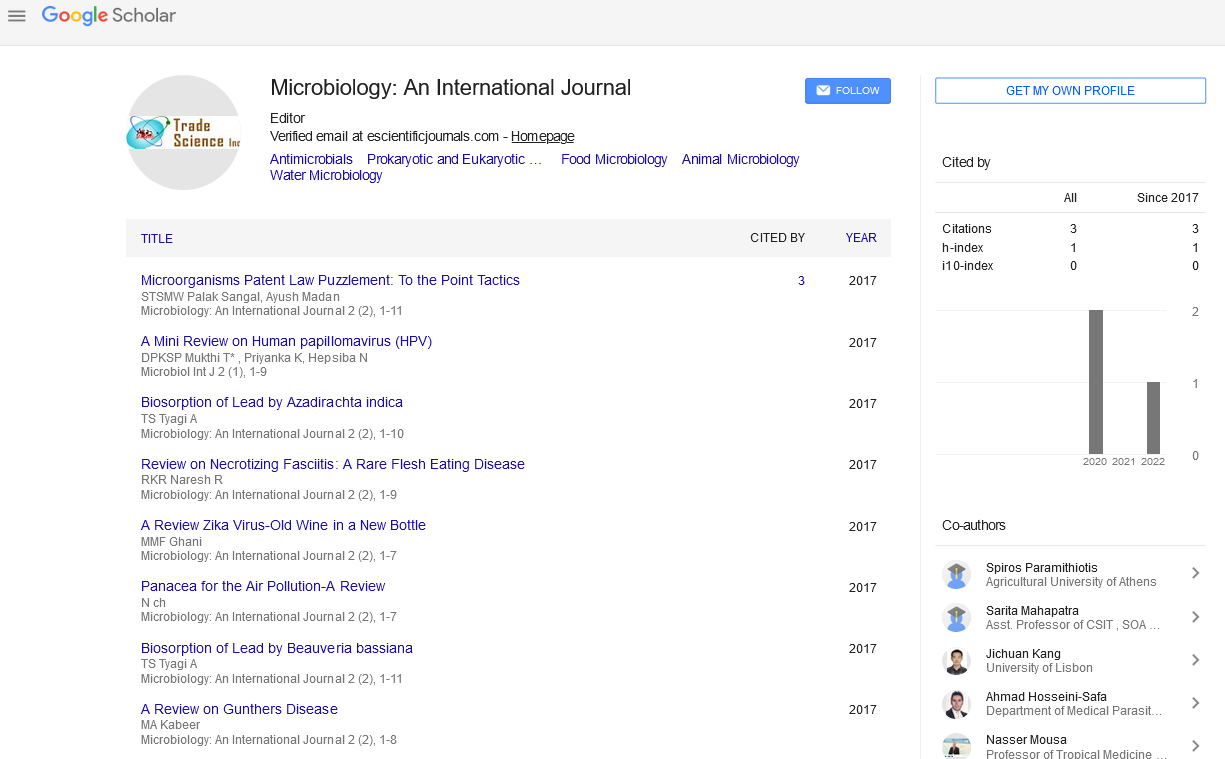Short communication
, Volume: 3( 3)Microbiology Laboratory Requirements for Cellular and Gene Therapy Product Sterility Testing in Low and Middle-Income Countries
- *Correspondence:
- Dinesh Mohan, Dayanand Medical College and Hospital, Ludhiana, India, E-mail: Mohan.d_68@yahoo.co.in
Received: November 19, 2021; Accepted: December 03, 2021; Published: December 10, 2021
Citation: Dinesh Mohan. Microbiology Laboratory Requirements for Cellular and Gene Therapy Product Sterility Testing in Low and Middle-Income Countries. Microbiol Int J. 3(3):130.
Abstract
Routine microbiology results are a valuable source of data for antimicrobial resistance (AMR) surveillance in both low- and middle-income countries (LMICs) and high-income countries. To generate AMR surveillance data, various approaches and strategies are used. We aimed to review strategies for AMR surveillance in LMICs using routine microbiology results and to highlight areas that require assistance in order to generate high-quality AMR data. Strategies for identifying AMR cases (including case-finding based on isolates from routine diagnostic specimens and case-based surveillance of clinical syndromes), collecting data (including cohort, point-prevalence survey, and case–control), sampling AMR cases (including lot quality assurance surveys), and processing and analyzing data for AMR surveillance in LMICs were all discussed
Keywords
Surveillance; Microorganism; Bacterial infections; Microfluidics; Antibiotics
Introduction
Antibiotic resistance surveillance (AMR) is the basic means of informing efforts to control the spread of AMR by generating evidence of regional, national and global guidelines and action plans [1]. The main objectives of AMR surveillance are providing empirical treatment guidelines and community evidence for clinical decision-making, benchmarking to assess the impact of stewardship interventions, and epidemiological. Includes target exposure estimation and detection. Comparison of spatial and temporal differences and changes, including outbreak detection. Various AMR monitoring modalities have been described by the World Health Organization [2]. Surveillance can be extensive or as a guard (limited catchment area). Continuous, temporary or periodic; passive (using data collected on a regular basis) or active (planned data collection is not available in any other way). Routine (regular systematic data collection); or extension (acquisition of additional data) [3]. These distinctions are important for standardizing the flow of monitoring data over time and space, and more important for guiding the collection of quality data. Regular laboratory isolates are available if more laboratories are available in both low- and middle-income countries and high-income countries, and microbiological tests are performed more frequently as part of standard treatment. Sentinel sites where passive AMR monitoring with microbiological data is essential The most commonly used approach. At the Sentinel site, AMR monitoring includes the collection, validation, interpretation, and reporting of vulnerability data.
Microbiological testing is an important tool for diagnosing bacterial infections and is the source of LMIC's AMR data. Optimization of existing tools for diagnosing bacterial infectious diseases, identifying bacteria and generating antimicrobial susceptibility data in the field is the basis of the AMR monitoring system. Potential approaches to enhancing laboratory systems and services in LMIC settings have already been discussed in detail. Here we focus on various strategies for AMR monitoring in humans, using data from the Institute of Microbiology generated as part of standard care. Systematic support to improve and maintain the quality of AMR data from LMICs, highlighting potential strengths, weaknesses, systematic errors, and biases that can occur at any stage of data collection [4].
Identify the required area. Various AMR monitoring strategies require a complete understanding of their limitations and potential biases to ensure the maximum use and interpretation of local routine microbiological data over time and space. For example, case-finding monitoring based on the results of clinical diagnostic samples is relatively easy to implement and maintain in an LMIC environment, while estimating the incidence and rate of AMR is biased due to inadequate use of microbiology. It is more susceptible. Case-based monitoring of clinical syndromes can be transferred to clinical practice, but produces useful statistics that require financial and technical support as well as community-based training to maintain it. An innovative AMR monitoring strategy that is easy to implement and maintain at minimal cost helps improve the availability and quality of LMIC's AMR data. The high incidence of multimicrobial infections and coagulase-negative staphylococci in this series is ideally best suited for hand osteomyelitis with early microbiological and histopathological confirmation by bone biopsy in suspicious cases [5].
Conclusion
The Infectious Diseases Society guidelines for diabetic foot ulcer provide some recommendations for osteomyelitis. These include the use of probe-to-bone tests, MRI as an image of choice when the diagnosis is uncertain after a simple x-ray, and bone biopsy for culture and histology without wound cleaning. It is included. Short-term administration of antibiotics (2-5 days) is sufficient for patients with radical resection (no tissue left). If the infection persists, a longer treatment period of 4 weeks or longer is appropriate.
References
- Garnacho-Montero J, Timsit, JF. Managing Acinetobacter baumannii infections. Curr Opin Infect D. 2019;32(1):69-76.
- Katsube T, Echols R, Wajima, T. Pharmacokinetic and pharmacodynamic profiles of cefiderocol, a novel siderophore cephalosporin. Clin Infect Dis. 2019;69(7):S552-S558.
- Kazmierczak KM, Tsuji M, Wise MG. In vitro activity of cefiderocol, a siderophore cephalosporin, against a recent collection of clinically relevant carbapenem-non-susceptible Gram-negative bacilli, including serine carbapenemase-and metallo-β-lactamase-producing isolates. Int J Antimicrob Agents. 2019;53(2):177-184.
- Bassetti M, Echols R, Matsunaga Y. Efficacy and safety of cefiderocol or best available therapy for the treatment of serious infections caused by carbapenem-resistant Gram-negative bacteria : a randomised, open-label, multicentre, pathogen-focused descriptive phase 3 trial. Lancet Infect Dis. 2021;21(2):226-240.
- Falcone M, Tiseo G, Nicastro M. Cefiderocol as rescue therapy for Acinetobacter baumannii and other carbapenem-resistant Gram-negative infections in intensive care unit patients. Clin Infect Dis. 2021;72(11):2021-2024.

